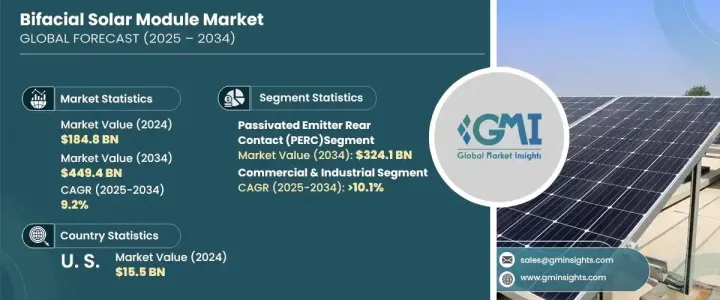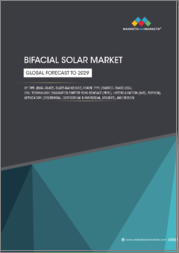
|
시장보고서
상품코드
1716566
양면 태양광 모듈 시장 : 기회, 성장 촉진요인, 산업 동향 분석 및 예측(2025-2034년)Bifacial Solar Module Market Opportunity, Growth Drivers, Industry Trend Analysis, and Forecast 2025 - 2034 |
||||||
세계의 양면 태양광 모듈 시장 규모는 2024년 1,848억 달러로 평가되었고, 2025년부터 2034년까지 연평균 성장률(CAGR) 9.2%로 성장할 것으로 예측됩니다.
이 시장의 빠른 성장은 대규모 에너지 프로젝트에서 고효율 태양광 솔루션에 대한 수요 증가와 발전량 향상을 위해 태양광 패널의 활성 면적을 최적화하려는 노력에 힘입어 촉진되고 있습니다. 재생 에너지로의 전환이 탄력을 받으면서 전 세계 산업계는 비용을 절감하면서 에너지 생산량을 극대화하는 첨단 태양광 기술에 집중하고 있습니다. 양면 태양광 모듈은 양쪽에서 햇빛을 포착할 수 있어 기존 패널에 비해 효율성이 높아 유틸리티, 상업용 및 산업용에 선호되는 기술입니다.

제조업체들은 효율을 높이고 채택률을 높이기 위해 n형 부동태화 이미터 후면 접촉(PERC), 터널 산화물 부동태화 접촉(TOPCon), 이종 접합 셀 등 최첨단 기술을 통합하고 있습니다. 이러한 혁신은 특히 기업이 지속가능성 목표를 달성하기 위해 노력하는 상황에서 여러 부문에 걸쳐 제품 보급을 촉진하는 데 매우 중요합니다. 확산된 태양광 아래에서 향상된 에너지 생산량과 다양한 설치 조건에 대한 적응성 등 양면 모듈의 장점에 대한 인식이 높아지면서 시장 확대가 더욱 가속화될 것으로 예상됩니다. 또한 정부의 인센티브, 우호적인 정책, 태양광 부품의 비용 하락은 주요 글로벌 시장에서 양면 모듈 채택을 장려하는 데 중추적인 역할을 하고 있습니다. 신흥 경제국에서도 태양광 인프라에 대한 투자가 증가하면서 양면 태양광 기술의 광범위한 구현을 더욱 뒷받침하고 있습니다.
| 시장 범위 | |
|---|---|
| 시작 연도 | 2024년 |
| 예측 연도 | 2025-2034년 |
| 시작 금액 | 1,848억 달러 |
| 예측 금액 | 4,494억 달러 |
| CAGR | 9.2% |
PERC 기술은 2034년까지 3,241억 달러의 가치가 예상되는 등 시장 성장에 크게 기여할 것으로 예상됩니다. 이 기술은 빛 흡수를 개선하고 전자 재결합을 최소화하여 에너지 변환 효율을 향상시킴으로써 업계의 판도를 바꿀 수 있는 기술입니다. 다양한 조명 조건에서 효율적으로 작동할 수 있는 태양광 솔루션에 대한 수요가 급증함에 따라 양면 모듈이 이상적인 솔루션으로 떠오르고 있습니다. 반사광과 산란광을 포착할 수 있기 때문에 설원이나 사막 환경과 같이 알베도 표면이 높은 지역에 특히 유용합니다. 기술 발전으로 신흥 시장에서 PERC 기반 모듈에 대한 접근성이 높아짐에 따라 시장 보급률이 증가할 것으로 보입니다.
상업 및 산업 부문은 운영 비용을 최소화하면서 더 높은 수율을 제공하는 에너지 효율적인 솔루션의 필요성에 따라 2034년까지 10.1%의 연평균 성장률을 보일 것으로 예상됩니다. 상업 및 산업 시설의 공간 억제요인으로 인해 효율성이 최우선 과제로 떠오르면서 양면 모듈의 채택이 증가하고 있습니다. 옥상, 건물 정면, 차고 등 다양한 곳에 설치할 수 있다는 장점 덕분에 제한된 공간에서 태양광 에너지 생산을 최적화하려는 기업에게 매력적인 옵션이 되고 있습니다.
2024년 155억 달러에 달하는 미국의 양면 태양광 모듈 시장은 태양광 설치의 초기 비용을 낮추기 위한 강력한 연방 인센티브와 정부 지원 정책으로 인해 주목을 받고 있습니다. 대규모 유틸리티 프로젝트에서 에너지 생산량 향상에 대한 요구로 인해 특히 야심찬 재생 에너지 의무를 가진 주에서 양면 기술 채택이 가속화되고 있습니다. 청정 에너지 목표를 달성하기 위해 노력하는 유틸리티 업체들로 인해 양면 태양광 모듈의 전개는 향후 몇 년 동안 크게 증가할 것으로 예상됩니다.
목차
제1장 조사 방법과 조사 범위
제2장 주요 요약
제3장 업계 인사이트
- 업계 생태계
- 규제 상황
- 업계에 미치는 영향요인
- 성장 촉진요인
- 업계의 잠재적 위험 및 과제
- 성장 가능성 분석
- Porter's Five Forces 분석
- PESTEL 분석
제4장 경쟁 구도
- 소개
- 전략 대시보드
- 혁신 및 지속가능성 전망
제5장 시장 규모와 예측 : 두께별(2021-2034년)
- 주요 동향
- 2mm 미만
- 2-3mm
- 3mm 이상
제6장 시장 규모와 예측 : 유형별(2021-2034년)
- 주요 동향
- 이중 유리 양면 태양광
- 유리-백시트 양면 태양광
제7장 시장 규모와 예측 : 용도별(2021-2034년)
- 주요 동향
- 주택
- 상업 및 산업
- 유틸리티
제8장 시장 규모와 예측 : 기술별(2021-2034년)
- 주요 동향
- 부동태화 이미터 후면 접촉(PERC)
- 터널 산화물 부동태화 접촉(TOPCon)
- 헤테로 접합(HJT)
제9장 시장 규모와 예측 : 프레임 유형별(2021-2034년)
- 주요 동향
- 프레임
- 프레임리스
제10장 시장 규모와 예측 : 지역별(2021-2034년)
- 주요 동향
- 북미
- 미국
- 캐나다
- 유럽
- 독일
- 스페인
- 네덜란드
- 폴란드
- 아시아태평양
- 중국
- 호주
- 인도
- 일본
- 중동 및 아프리카
- UAE
- 튀르키예
- 이집트
- 라틴아메리카
- 브라질
- 칠레
제11장 기업 프로파일
- 3Sun
- Boviet Solar
- Canadian Solar
- First Solar
- Hanwha Q CELLS
- JA Solar Technology
- Jinko Solar
- LONGi Green Energy Technology
- Reliance New Energy
- Sharp Corporation
- Sunergy
- Trina Solar
- Vikram Solar
The Global Bifacial Solar Module Market was valued at USD 184.8 billion in 2024 and is projected to expand at a CAGR of 9.2% between 2025 and 2034. The market's rapid growth is fueled by the rising demand for high-efficiency solar solutions in large-scale energy projects and efforts to optimize the active area of solar panels for improved power generation. As the shift toward renewable energy gains momentum, industries worldwide are focusing on advanced photovoltaic technologies that maximize energy output while reducing costs. The ability of bifacial solar modules to capture sunlight from both sides increases their efficiency compared to conventional panels, making them a preferred choice for utility, commercial, and industrial applications.

Manufacturers are integrating cutting-edge technologies, including n-type Passivated Emitter Rear Contact (PERC), Tunnel Oxide Passivated Contact (TOPCon), and Heterojunction cells, to enhance efficiency and boost adoption rates. These innovations are crucial in driving product penetration across multiple sectors, especially as companies strive to meet sustainability goals. The growing awareness of bifacial modules' advantages-such as improved energy generation under diffused sunlight and their adaptability to various installation conditions-is expected to further accelerate market expansion. Additionally, government incentives, favorable policies, and decreasing costs of solar components are playing a pivotal role in encouraging adoption across key global markets. Emerging economies are also witnessing increased investments in solar infrastructure, further supporting the widespread implementation of bifacial solar technology.
| Market Scope | |
|---|---|
| Start Year | 2024 |
| Forecast Year | 2025-2034 |
| Start Value | $184.8 Billion |
| Forecast Value | $449.4 Billion |
| CAGR | 9.2% |
The PERC technology is anticipated to significantly contribute to the market's growth, with a projected valuation of USD 324.1 billion by 2034. This technology enhances energy conversion efficiency by improving light absorption and minimizing electron recombination, making it a game-changer in the industry. As demand surges for solar solutions that can perform efficiently in varied lighting conditions, bifacial modules are becoming an ideal solution. Their ability to capture reflected and scattered light makes them particularly beneficial for regions with high albedo surfaces, such as snowy landscapes and desert environments. With technological advancements making PERC-based modules more accessible in emerging markets, their market penetration is poised to rise.
The commercial and industrial sectors are expected to witness a CAGR of 10.1% by 2034, driven by the need for energy-efficient solutions that deliver higher yields while minimizing operational expenses. Space constraints in commercial and industrial installations make efficiency a top priority, leading to the increased adoption of bifacial modules. Their versatility in installation-whether on rooftops, building facades, or carports-adds to their appeal, making them a viable option for businesses looking to optimize solar energy production in limited spaces.
The U.S. Bifacial Solar Module Market, valued at USD 15.5 billion in 2024, is gaining traction due to strong federal incentives and government-backed policies aimed at lowering the upfront costs of solar installations. The demand for improved energy yields in large-scale utility projects is accelerating the adoption of bifacial technology, particularly in states with ambitious renewable energy mandates. With utilities striving to meet clean energy targets, the deployment of bifacial solar modules is expected to grow significantly in the coming years.
Table of Contents
Chapter 1 Methodology & Scope
- 1.1 Market definitions
- 1.2 Base estimates & calculations
- 1.3 Forecast calculation
- 1.4 Primary research & validation
- 1.4.1 Primary sources
- 1.4.2 Data mining sources
- 1.5 Market definitions
Chapter 2 Executive Summary
- 2.1 Industry synopsis, 2021 – 2034
Chapter 3 Industry Insights
- 3.1 Industry ecosystem
- 3.2 Regulatory landscape
- 3.3 Industry impact forces
- 3.3.1 Growth drivers
- 3.3.2 Industry pitfalls & challenges
- 3.4 Growth potential analysis
- 3.5 Porter's analysis
- 3.5.1 Bargaining power of suppliers
- 3.5.2 Bargaining power of buyers
- 3.5.3 Threat of new entrants
- 3.5.4 Threat of substitutes
- 3.6 PESTEL analysis
Chapter 4 Competitive landscape, 2024
- 4.1 Introduction
- 4.2 Strategic dashboard
- 4.3 Innovation & sustainability landscape
Chapter 5 Market Size and Forecast, By Thickness, 2021 - 2034 (USD Billion)
- 5.1 Key trends
- 5.2 < 2 mm
- 5.3 2 mm to 3 mm
- 5.4 > 3 mm
Chapter 6 Market Size and Forecast, By Type, 2021 - 2034 (USD Billion)
- 6.1 Key trends
- 6.2 Dual-Glass bifacial solar
- 6.3 Glass-Backsheet bifacial solar
Chapter 7 Market Size and Forecast, By Application, 2021 - 2034 (USD Billion)
- 7.1 Key trends
- 7.2 Residential
- 7.3 Commercial & industrial
- 7.4 Utility
Chapter 8 Market Size and Forecast, By Technology, 2021 - 2034 (USD Billion)
- 8.1 Key trends
- 8.2 Passivated emitter rear contact (PERC)
- 8.3 TOPCon
- 8.4 Heterojunction (HJT)
Chapter 9 Market Size and Forecast, By Frame Type, 2021 - 2034 (USD Billion)
- 9.1 Key trends
- 9.2 Framed
- 9.3 Frameless
Chapter 10 Market Size and Forecast, By Region, 2021 - 2034 (USD Billion)
- 10.1 Key trends
- 10.2 North America
- 10.2.1 U.S.
- 10.2.2 Canada
- 10.3 Europe
- 10.3.1 Germany
- 10.3.2 Spain
- 10.3.3 Netherlands
- 10.3.4 Poland
- 10.4 Asia Pacific
- 10.4.1 China
- 10.4.2 Australia
- 10.4.3 India
- 10.4.4 Japan
- 10.5 Middle East & Africa
- 10.5.1 UAE
- 10.5.2 Turkey
- 10.5.3 Egypt
- 10.6 Latin America
- 10.6.1 Brazil
- 10.6.2 Chile
Chapter 11 Company Profiles
- 11.1 3Sun
- 11.2 Boviet Solar
- 11.3 Canadian Solar
- 11.4 First Solar
- 11.5 Hanwha Q CELLS
- 11.6 JA Solar Technology
- 11.7 Jinko Solar
- 11.8 LONGi Green Energy Technology
- 11.9 Reliance New Energy
- 11.10 Sharp Corporation
- 11.11 Sunergy
- 11.12 Trina Solar
- 11.13 Vikram Solar



















